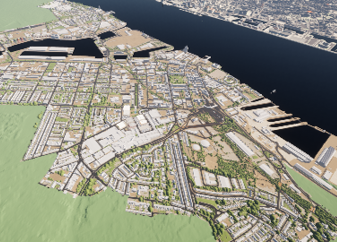By Simon Mabey, Director
The government has made much of it plans to “level up” British cities, but many of the practicalities of this are unclear. To improve urban centres, local authorities need the tools to visualise current conditions and predict the impact of future changes. This is easy for large cities with the budgets to match, but many councils have been left looking for affordable ways to plan ambitious projects.
Could digital twinning provide the answer?
Levelling Up
The levelling up agenda was developed in response to economic and social inequalities. Many parts of the UK feel left behind, without the wealth seen in London and the south-east. Under levelling up, investment has been promised for towns and cities outside that region, as well as greater local control over how money is spent.
Connected to this is talk about the collapse of the high street. Changes in the way we shop, work, and socialise have triggered a decline in town and city centre businesses. The coronavirus pandemic and its economic fallout has accelerated that process.
This has placed an onus on city and borough councils to renew urban centres. With more money comes more responsibility. Ways must be found to bring customers and employers back into the heart of the urban sprawl. Transport networks need to be developed to improve connections and encourage growth.
Given the origins of the phrase “levelling up” in computer games, it is fitting that one of the tools supporting this agenda is also driven by games technology.
What is Digital Twinning?
Digital twinning is the creation of a virtual 3D version of a town or city, based on real life data. Planners, developers, and construction companies can use this model to explore the town, examining it from all sorts of angles, observing how processes work within the urban environment and how that environment would respond to changes, such as new buildings, altered transport networks, or demographic shifts.
Visualisation is central to digital twinning. Looking at a map provides some sense of how a town is shaped in theory, but a 3D model lets you see how it works in practice. Where are the lines of sight, the traffic bottlenecks, the still or busy places?
How would all that change if a shopping centre was built or a tram line added?
Digital twinning creates a 3D snapshot of a town as it is now, and through that a window into possible futures.
Not Just for Big Cities
The tools to do this have existed for years, thanks to live data and 3D modelling, but the time and costs involved were often prohibitive. Now, the software engines that drive multi-million-dollar games can be brought to bear on even more expensive projects: the development of entire towns.
The highest profile examples have been cities like Singapore and Lucerne, which have incorporated digital twinning into their planning processes. But such large and wealthy settlements are outliers. It is smaller towns that demonstrate the widespread value of digital twinning.
“Birkenhead is changing,” explains Cathy Wignall, Regeneration Delivery Lead at Wirral Council, “and we need to set out the scope of our ambition and for the residents and the stakeholder and central government to understand the scale of our ambition. The use of 3D modelling provided by Digital Urban has proved to be an ideal way of bringing this vision to reality and to life.”
The model in question covers nine square kilometres of Birkenhead, a town within the Wirral. Consolidating proposed changes from a range of different sources, it presents a concrete vision of what the town will look like in 2040. Residents can see, understand, and engage with the changes. Companies can make investments, knowing what the town will look like.
In some ways, it is a remarkable step to take, creating a digital planning tool for a town of only 89,000 residents. But with 3D visualisation available in every living room through games consoles, it makes sense to tap into it for grander ends. Companies like Digital Urban have made this technology available at a scale suitable for town and borough councils.
Birkenhead is not likely to feature in the next Assassins Creed, but by tapping into the same technology, it will get to level up.












